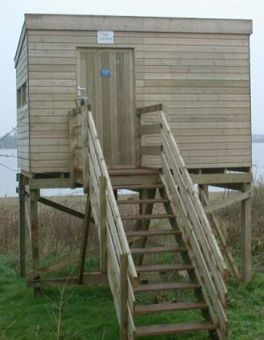Belvide Reservoir facts for kids
Quick facts for kids Belvide Reservoir |
|
|---|---|

The 'Gazebo' hide at the West Midland Bird Club's Belvide Reservoir reserve
|
|
| Location | South Staffordshire |
| Coordinates | 52°41′10″N 2°11′35″W / 52.686°N 2.193°W |
| Type | Canal reservoir |
| Basin countries | United Kingdom |
| Managing agency | British Waterways |
| Designation | SSSI |
| Built | 1833 |
| Surface area | 737,000 square metres (182 acres) |
| Water volume | 2,196,000 cubic metres (483×106 imp gal) |
Belvide Reservoir is a large reservoir located in South Staffordshire, England. It was built a long time ago, in 1833, to provide water for the Birmingham and Liverpool Junction Canal. Since 1977, it has also been looked after as a special nature reserve. Scientists have even used it to study how changes in water levels affect the different types of birds that live there.
Contents
Building the Reservoir
Belvide Reservoir is currently owned by the Canal & River Trust. It was built around 1833 to supply water to the Birmingham and Liverpool Junction Canal. This canal later became part of the Shropshire Union Canal in 1846.
Work on the reservoir started in 1832. The canal itself opened a few years later, in early 1835. The canal was very busy, and more water was needed. Because of this, the reservoir was made even bigger. This expansion was completed in 1842.
Old Valve House
The special equipment that controls the water flowing from the reservoir to the canal is thought to be the original. It is kept inside a round building called a valve house. This building and its curved brick wall were designed by a famous engineer named Thomas Telford. They are very important historical structures, known as Grade II* listed buildings. The valve house has a unique cast iron dome and is a rare example of its kind.
How Big Is It?
When the water levels are at their highest, Belvide Reservoir covers an area of about 180 acres (73 ha). However, the water level changes a lot because water is used for the canal. When the water level drops by about 12 feet (3.7 m), the surface area becomes almost half of its largest size. The reservoir gets its water from a small river that flows into the River Penk.
A Home for Wildlife
Belvide Reservoir is a very important place for nature. It has been a nature reserve since January 1977, managed by the West Midland Bird Club. It is also officially recognized as a Site of Special Scientific Interest (SSSI). This means it's a protected area because of its special wildlife.
Visiting the Reserve
The reserve is not open to everyone. You need a special permit to visit it. This helps protect the sensitive wildlife that lives there.
Birdwatching History
People have been interested in birdwatching at Belvide Reservoir since the 1920s. A bird expert named Arnold Boyd used to visit and write about the birds he saw. He called the place "Bellfields" in his articles to keep its real location a secret.
Many rare and unusual migrant birds have been seen at the reservoir over the years. Some of these special visitors include the white-winged black tern, whiskered tern, Caspian tern, spotted crake, and spotted sandpiper.
Water Levels and Birds
Studies have been done at the reservoir to understand how changing water levels affect bird populations. These studies help experts figure out the best way to manage the water to help different types of wildlife.
Sometimes, there are different needs. For example, ducks that are moulting (losing their old feathers) like pochard, shoveller, and tufted duck do well when water levels stay steady in summer. But if the water levels drop a lot, it creates better conditions for wading birds.
When a big drop in water level happens, the shallow areas get a fresh start. Dabbling ducks like teal are most common when the reservoir is refilling. Diving ducks, on the other hand, are most numerous about a year after a big water level drop.
Location
Belvide Reservoir is located just south of the A5 road. This road follows the path of an ancient Roman road called Watling Street. The canal is a bit to the east and crosses the A5 road at Stretton Aqueduct. Any extra water from the reservoir flows under the canal to reach the River Penk, which is a little further east. The closest village to the reservoir is Brewood, which is about 1 mile (1.6 km) to the south-east.


